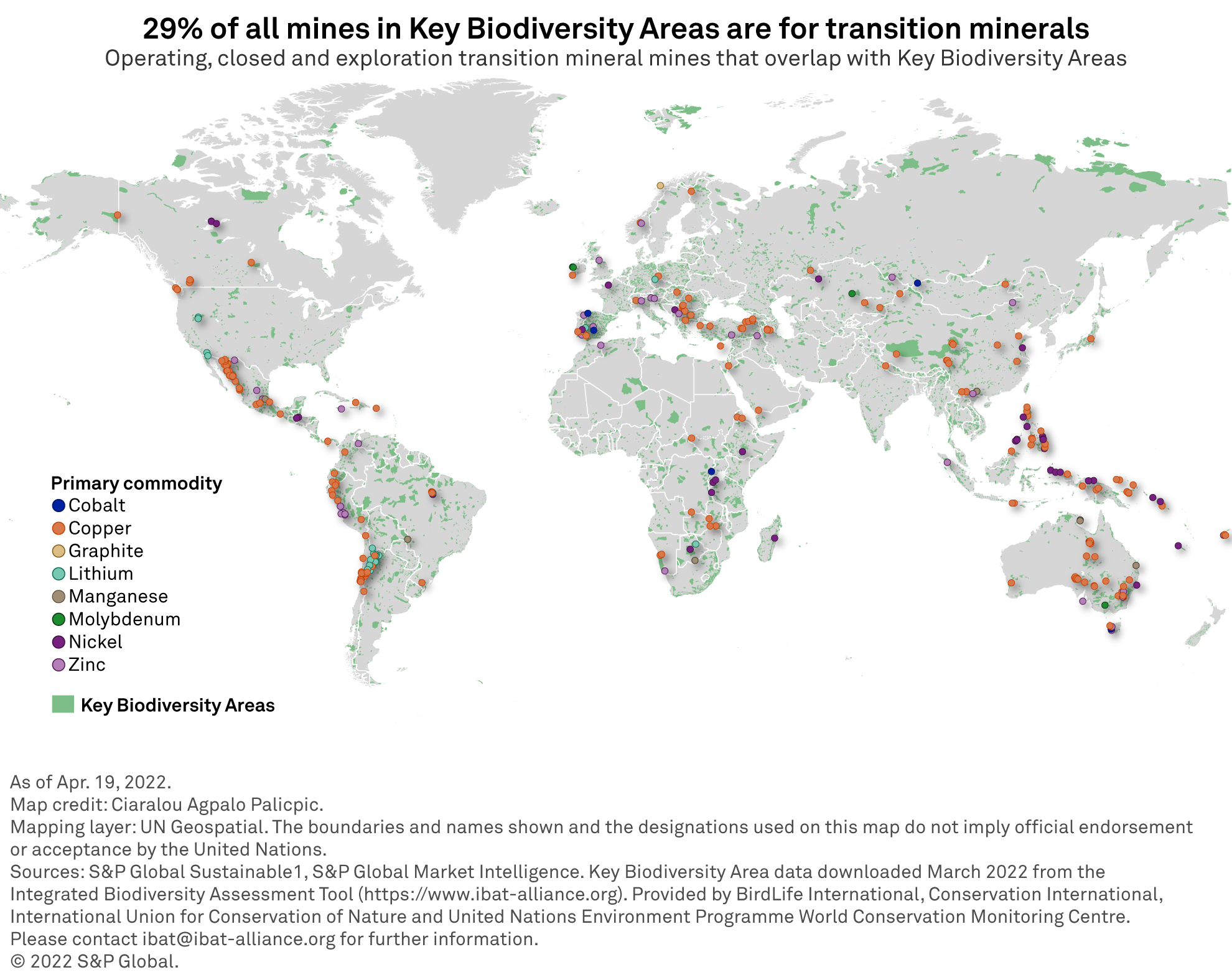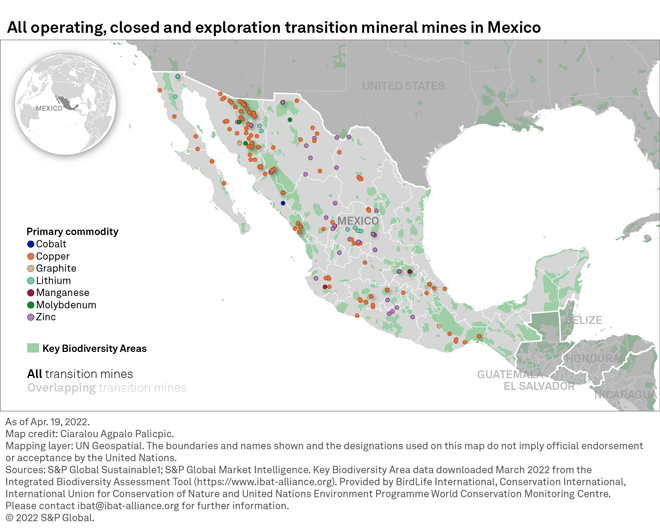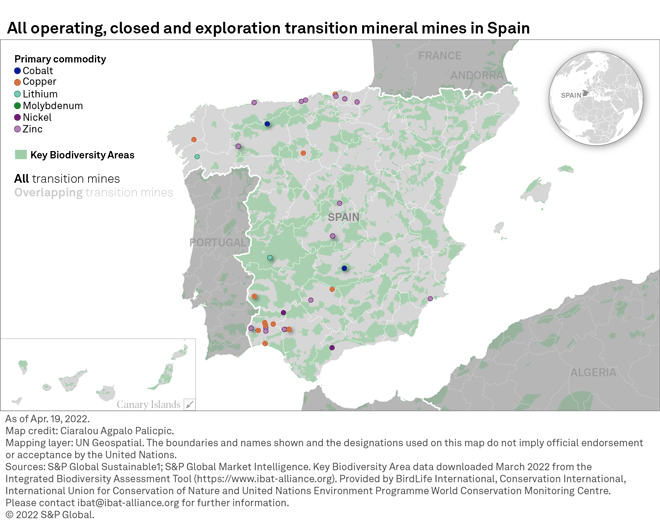Authors: Esther Whieldon, Joerg Rueedi, Shirley Yap, Gautier Desme
Published: November 22, 2022
Low-carbon energy transition pathways predict a massive expansion in the supply of rare minerals, and companies are exploring hundreds of new sites globally that have mining potential.
More than 1,200 mining sites lie within Key Biodiversity Areas, and 29% of those sites are for energy transition minerals, according to a new analysis from S&P Global Sustainable1 based on data accessed through collaboration with UNEP-WCMC
Accessing more of these minerals to expand low-emissions technologies like electric vehicles, solar energy and batteries can create pressures on biodiversity, undermining the resilience of ecosystems and their role in addressing climate change.
Pathways to transition the global economy away from fossil fuels predict a massive expansion of the supply of critical minerals, and mining exploration around the world is picking up as companies seek out new deposits of elements like cobalt, lithium and copper.
But while access to more of these minerals is key to ramping up low-carbon technologies like electric vehicles and solar panel manufacturing, the process of extracting them — from exploring potential sites to closing depleted mines — poses significant threats to the ecosystems and species that often coincide with potential mineral deposits. A new analysis from S&P Global Sustainable1 finds that many existing mines and exploration sites that could become mines overlap with some of the world’s most important areas for biodiversity.
This presents a complicated problem: How does the world attain the mineral resources needed to enable the energy transition while managing the potential negative impacts on biodiversity? How do we minimize tradeoffs arising between efforts to conserve nature and reduce emissions? These questions take on greater urgency as the world better understands that trillions of dollars of economic activity rely on biodiversity. Looming above this challenge is the basic fact that failing to lower greenhouse gas emissions will continue to cause dramatic losses to biodiversity in the coming decades.
About 5% of the more than 24,500 operational mines and exploration sites around the world are in Key Biodiversity Areas, or KBAs, according to the analysis conducted by S&P Global Sustainable1 based on data accessed through collaboration with UNEP-WCMC, the UN Environment Programme World Conservation Monitoring Centre. KBAs are sites deemed by the scientific community as contributing significantly to the global persistence of biodiversity. The KBA designation does not carry legal protection, but many KBAs overlap with protected areas such as national parks or wildlife reserves. As of September 2021, about 16,000 KBAs have been defined, and scientists may identify more in the future, including in areas where mines already exist.
Of the 1,276 mining sites that intersect with KBAs, 29% are for extracting minerals needed for the low-carbon energy transition. Moreover, of these transition mineral sites in KBAs, 67% are exploration sites, meaning they are being assessed for future development into operational mines to meet the demands of the energy transition.

Mining sites for transition minerals overlap with KBAs in 65 countries around the world. In some countries where mining development is more widespread, a significant portion of mining for transition minerals is taking place within KBAs. There are more than a dozen countries with at least 10 transition mineral mines and where 10% or more of those mining sites overlap with KBAs.
Countries where 10% or more of transition mineral mining sites overlap with KBAs
| Country | Total number of transition mine sites | Transition mine sites overlapping with KBAs | Percentage of transition mine sites overlapping with KBAs | Transition minerals (number of sites overlapping with KBAs) |
|---|---|---|---|---|
| Turkey | 43 | 19 | 44% | Copper (17), zinc (2) |
| Ecuador | 24 | 7 | 29% | Copper (7) |
| Philippines | 105 | 30 | 29% | Copper (14), zinc (5) |
| Mexico | 161 | 46 | 29% | Copper (37), lithium (1), manganese (2), zinc (6) |
| Papua New Guinea | 34 | 9 | 26% | Copper (9) |
| Italy | 17 | 4 | 24% | Copper (4) |
| Spain | 36 | 8 | 22% | Cobalt (2), copper (2), lithium (1), zinc (3) |
| Bulgaria | 10 | 2 | 20% | Copper (2) |
| Argentina | 112 | 18 | 16% | Copper (10), lithium (10) |
| Indonesia | 91 | 13 | 14% | Copper (5), nickel (7), zinc (1) |
| Portugal | 18 | 2 | 11% | Copper (1), nickel (1) |
| Germany | 19 | 2 | 11% | Copper (1), lithium (1) |
| Serbia | 38 | 4 | 11% | Copper (2), nickel (1), zinc (1) |
| Botswana | 30 | 3 | 10% | Lithium (1), manganese (2), nickel (1) |
Data as of April 19, 2022.
KBA = Key Biodiversity Area. Transition minerals include cobalt, copper, graphite, lithium, manganese, molybdenum, nickel and zinc.
Table includes countries that have at least 10 transition mineral mining sites and where 10% or more of transition mineral mining sites overlap with KBAs.
Mapping layer: Natural Earth.
Sources: S&P Global Sustainable1, S&P Global Market Intelligence. Key Biodiversity Area data downloaded March 2022 from the Integrated Biodiversity Assessment Tool (IBAT) (https://www.ibat-alliance.org). Provided by BirdLife International, Conservation International, IUCN and UNEP-WCMC. Please contact ibat@ibat-alliance.org for further information.
© 2022 S&P Global.
Take Mexico, for example, where about 29% of transition mineral mining sites overlap with KBAs. More than a dozen of those transition mineral mining sites intersect with KBAs in the massive Sierra Madre Occidental, or SMO, mountain range, which consists of highland plateaus, mixed forests and deeply cut canyons. The SMO extends about 700 miles from northwestern Mexico near the U.S. border to the southeastern part of the country.
The SMO has some of the richest diversity of ecosystems and species in North America. BirdLife International, a conservation group that helps identify KBAs, describes the canyon corridor of the SMO as a refuge for bird species including parrots, macaws and the golden eagle and mammals such as the jaguar, ocelot and river otter. Companies are exploring four mining sites for copper and zinc in this KBA.

Countries with significant overlap exist around the world, including in regions that have made protecting biodiversity a priority. The EU has set out a biodiversity strategy with a 2030 target date that includes turning at least 30% of its land and sea area into protected areas. But in Spain, for example, 22% of transition mineral mines are in KBAs — a significant share of its contribution to supplying the energy transition with needed minerals. These locations are for a variety of transition minerals — cobalt, zinc, copper and lithium — and nearly all are in the exploration stage. These sites overlap with KBAs that are home to endangered species including the Iberian minnowcarp, which could be threatened by habitat destruction imposed by the exploration process and by potential water pollution.

Global biodiversity is already in rapid decline due to human activity and climate change. The world has experienced an average decrease of 69% in the populations of mammals, birds, reptiles, amphibians and fish since 1970, according to the World Wildlife Fund. Hitting what the World Bank has called “ecological tipping points” of damage to some natural services could hurt global GDP by $2.7 trillion annually by 2030.
Mining has the potential to degrade habitats and harm biodiversity both directly and indirectly: not only at a mining site itself but also through road and railway development in nearby areas. Building this infrastructure can increase access to remote, biologically diverse areas and lead to significantly higher human populations, as well as hunting and other business activities that otherwise might not have occurred.
Another direct risk to biodiversity comes from a mining waste byproduct called tailings. Tailings are a liquid slurry of pulverized rock, water and leftover extraction chemicals that remain on-site and must be treated after the target minerals are separated from the ore. Tailings are stored in dams that, if they fail, can pollute downstream waters and wreak havoc on ecosystems. Past major tailings dam failures have caused fatalities and catastrophic damage to local communities, economies and nature.
The S&P Global Corporate Sustainability Assessment, or CSA, has collected data on mining companies’ tailings adherence to tailings management standards, and this data has become even more relevant in the aftermath of recent tailings failures that led the industry to publish international standards for tailings management in 2020. However, major dam collapses have occurred as recently as September 2022.
CSA data shows that a majority of assessed mining firms now report their active tailings sites, and an increasing number are conducting audits. However, little progress has been made on aspects of tailings management that are relevant to avoiding biodiversity impacts and maintaining dams into the future, such as decommissioning procedures and life of mine facility plans. Better tailings management could have a two-fold benefit: lessening the impact of tailings dams on the local ecosystem and lowering the chance of failure, which can cost firms billions of dollars in cleanup costs and serious reputational damage in addition to harm to both people and biodiversity.
Despite its potential harm to ecosystems, mining for energy transition minerals is a key part of transitioning toward low-carbon energy and technologies. The world needs to act quickly to reduce greenhouse gas emissions to limit global warming and avoid potentially catastrophic impacts to society and nature alike.
The low-carbon transition will require a massive expansion of renewable generation, high-voltage power lines and electric vehicles, according to the International Energy Agency's World Energy Outlook Special Report released in May 2021. Many low-carbon technologies will require significantly larger amounts of certain minerals than their fossil-fuel based counterparts. For example, the IEA estimates that electric cars, which rely on lithium, nickel, cobalt, manganese and graphite for electric batteries — need about 6x the amount of minerals of a conventional combustion car.
One indication of where companies are considering developing new mines or expanding existing ones is their exploration budgets. Companies use the exploration process to determine if there are sufficient minerals under the ground to warrant moving forward with development. Of the energy transition-related mining sites in KBAs around the world, 67% are exploration sites, our analysis finds.
Meanwhile, mining companies have collectively ramped up their exploration budgets for many of the minerals needed for technologies such as wind and solar power, utility-scale battery storage and electric vehicles.
From 2016 through 2021, the aggregate exploration budgets of mining companies worldwide increased for copper, nickel, lithium, cobalt, molybdenum and zinc, according to S&P Global Market Intelligence data. The biggest increase over that five-year period was for cobalt, which is a key component to electric vehicle batteries and battery storage. The global aggregate exploration budget for cobalt increased by 733% from 2016 through 2021, from $8.4 million to $70 million. Even so, cobalt’s exploration budget is still far lower than many other transition minerals.
While exploration budgets are rising for transition minerals, global production may struggle to meet demand in the near term, which could affect the pace of the low-carbon transition. Exploration does not mean production is coming online quickly. If a company does decide to pursue an exploration site, obtaining development permits can take up to 10 years, depending on the country of jurisdiction.
Demand for some minerals is particularly durable. S&P Global Market Intelligence in its World Exploration Trends 2022 report projected that "soaring demand for lithium as a major battery component will keep the market in deficit in the near and medium terms, as growth in supply will lag due to pandemic-related disruptions."
Meanwhile, demand for copper will double by 2035, creating a supply gap that could threaten climate goals and pose serious challenges to reaching net zero emissions by 2050, according to research by S&P Global’s Economics & Country Risk, Commodity Insights, and Mobility teams.
In the face of potential supply shortfalls, alternatives to mining for critical minerals are emerging. Some of those alternatives, such as minerals and metals recycling, could also reduce threats to biodiversity to the extent that they decrease the need for mining.
A 2022 study by researchers at Belgian university KU Leuven found that Europe faces critical shortfalls in transition minerals in the next 15 years, but those shortfalls could be reduced if Europe invests more in metals recycling. Up to 75% of Europe’s clean energy metal needs could be met through local recycling by 2050 if Europe quickly ramps up investments in the circular economy, the study found.
The IEA has also suggested a circular economy approach could help reduce primary supply requirements for minerals for electric vehicle batteries by about 10% by 2040.
At the center of the tradeoff between supplying the energy transition with minerals and limiting the impact on biodiversity are the voluntary commitments to preserving nature companies are willing to make.
Corporate pledges to protect nature are increasing, but they remain rare. Research by S&P Global Sustainable1 has found wide variations in commitments to protecting biodiversity and ecosystem services. According to CSA findings, no assessed industry has a majority of companies making nature-related commitments. For the metals and mining industry, the share of companies with a nature-related pledge of any kind was 20%.
That could change if the regulatory landscape on biodiversity begins to shift. Governments from around the world will discuss an updated set of goals at the Conference of the Parties to the Convention on Biological Diversity, commonly known as COP15, in December 2022 in Montreal, Canada. The current draft framework proposes to conserve at least 30% of land and sea globally by 2030 and restore at least 20% of degraded freshwater, marine and terrestrial ecosystems by the same year.
Meanwhile, other initiatives are underway to help financial institutions, companies and investors understand and manage biodiversity risks. The recently launched Taskforce on Nature-related Financial Disclosures, or TNFD, aims to create a framework of definitions, benchmarks and indicators that allow companies to measure, report and eventually address nature-related risks. The TNFD has released beta frameworks that some institutions are already pilot testing. S&P Global is a member of the TNFD.
For the mining sector, new voluntary standards and guidelines have been released or updated in recent years, including by the International Council on Mining and Metals, or ICMM). In June 2022, ICMM updated its mining principles on 10 issues including the human rights of workers and local communities impacted by mining and improving environmental performance metrics such as water usage.
CSA data shows that mining companies have shown improvement in their engagement with local and Indigenous communities affected by mine development. In the 2021 CSA, more than 40% of assessed mining companies provided evidence that they identify affected communities, implemented a stakeholder engagement plan and put a community grievance mechanism in place. However, it remains uncommon for companies to follow the principle of free, prior and informed consent — a key aspect of respecting the rights of Indigenous peoples and local communities.
The ICMM’s updated principles also include one dedicated specifically to protecting biodiversity. Principle 7 asks companies not to explore or mine in World Heritage sites and respect “legally designated protected areas.” It also sets “the ambition of achieving no-net-loss of biodiversity” for new projects and major expansions to existing projects.
While KBAs are identified by scientists, and the designation is unrelated to any legal status, they have informed the creation of protected areas in the past and conservation groups expect KBAs will continue to do so. KBAs where mines currently operate or are being explored could evolve into protected areas over time, presenting another complication for mining firms.
There is no easy solution to balancing the conservation of species and ecosystems with the needs of the energy transition. The problem is both global in scope yet local in impact and will require the entire mining sector to adopt a comprehensive approach to minimizing their impacts on biodiversity. However, some mining sites have greater potential for biodiversity harm than others, and companies and investors could prioritize their efforts on overseeing these mining sites to have the greatest impact on conservation. The UN Environment Programme Finance Initiative and the Natural Capital Finance Alliance found in 2021 that more than half of the mining sector’s potential for reducing species extinction risk is concentrated in only 2% of mines worldwide. Better biodiversity management in just this small portion of mining sites as a starting point could have an outsized benefit.